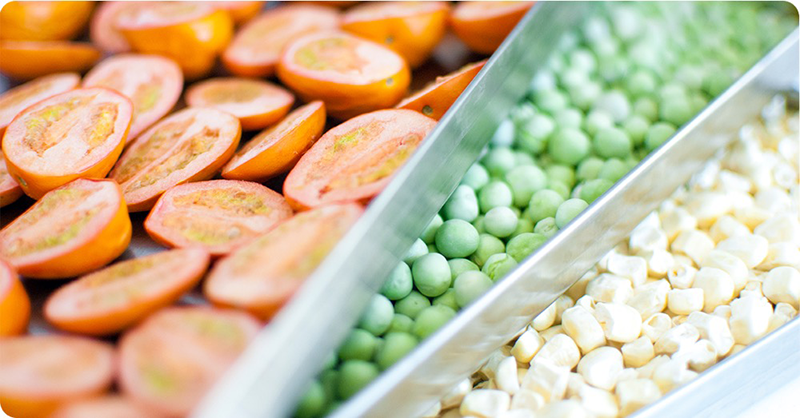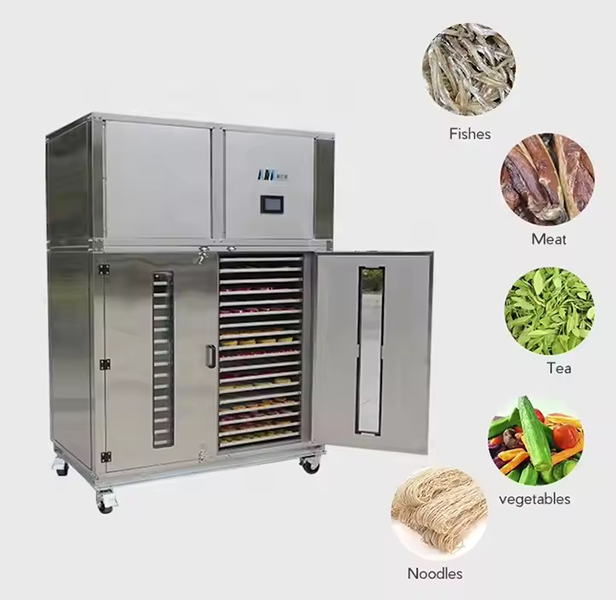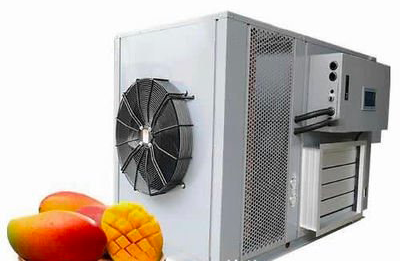
Content Menu
● Understanding Heat Pump Condenser Dryers
>> What is a Heat Pump Condenser Dryer?
● Advantages of Heat Pump Condenser Dryers
● How Do Heat Pump Condenser Dryers Work?
● Comparing Heat Pump Condenser Dryers to Traditional Dryers
● Applications in Food Processing
● Cost Considerations
● Maintenance of Heat Pump Condenser Dryers
● Future Trends in Food Drying Technology
● Conclusion
● FAQ
>> 1. What are the main benefits of using a heat pump condenser dryer for food processing?
>> 2. Can heat pump dryers be used for all types of food?
>> 3. How do heat pump dryers compare in terms of cost?
>> 4. Are there any downsides to using heat pump condensers?
>> 5. What maintenance do heat pump condenser dryers require?
In the realm of food processing, drying is a crucial step that significantly impacts the quality, shelf life, and safety of food products. Among the various technologies available for drying, heat pump condenser dryers have emerged as a noteworthy alternative to traditional dryers. This article will delve into the features, advantages, and applications of heat pump condenser dryers in the food drying industry, comparing them with traditional drying methods.

Understanding Heat Pump Condenser Dryers
What is a Heat Pump Condenser Dryer?
A heat pump condenser dryer utilizes a heat pump system to dry food products efficiently. Unlike traditional dryers that expel hot air, heat pump dryers recycle the air within the system. They draw moisture from the food and transfer it to a refrigerant, which is then condensed and removed, allowing for continuous operation without losing significant amounts of heat.
Advantages of Heat Pump Condenser Dryers
- Energy Efficiency: Heat pump dryers are known for their energy efficiency. They operate at lower temperatures compared to traditional dryers, which means they consume less energy while effectively removing moisture from food products.
- Gentle Drying Process: The lower drying temperatures help preserve the nutritional value and flavor of the food. This is particularly important for sensitive products like fruits and vegetables.
- Environmentally Friendly: These dryers have a reduced carbon footprint compared to traditional drying methods. By using less energy and recycling air, they contribute to sustainable practices in food processing.
- Versatility: Heat pump dryers can handle a wide range of products, including fruits, vegetables, herbs, and meats. Their adjustable settings allow processors to tailor the drying process to specific product requirements.
- Consistent Quality: The controlled environment in heat pump dryers ensures uniform drying across all products. This consistency helps maintain quality standards that are crucial for commercial food production.
How Do Heat Pump Condenser Dryers Work?
Heat pump condenser dryers operate on a closed-loop system. Here's a simplified breakdown of the process:
1. Air Intake: The dryer draws in ambient air.
2. Heating: The air passes through an evaporator coil where it is heated by the refrigerant.
3. Drying: The warm air is circulated over the food products, absorbing moisture.
4. Condensation: The moisture-laden air then passes through a condenser where it cools down, causing water vapor to condense into liquid form.
5. Recycling: The cooled air is reheated and recirculated back into the drying chamber.
This cycle continues until the desired moisture content is achieved in the food products.
Comparing Heat Pump Condenser Dryers to Traditional Dryers
| Feature | Heat Pump Condenser Dryer | Traditional Dryer |
| Energy Consumption | Low | High |
| Operating Temperature | Low | High |
| Environmental Impact | Minimal | Significant |
| Product Quality Preservation | High | Variable |
| Versatility | High | Moderate |
| Initial Cost | Higher | Lower |
Applications in Food Processing
Heat pump condenser dryers are increasingly being adopted in various sectors of food processing due to their numerous benefits:
- Fruit Drying: Ideal for drying fruits like apples, bananas, and berries while maintaining their color and taste. The gentle drying process prevents browning and preserves vitamins.
- Vegetable Drying: Effective for dehydrating vegetables such as carrots and bell peppers without losing essential nutrients. This method retains more flavor compared to traditional high-temperature methods.
- Herb Drying: Preserves the aromatic properties of herbs like basil and thyme through gentle drying processes that prevent essential oil loss.
- Meat Drying: Suitable for producing jerky or dehydrated meat products while ensuring safety through effective moisture removal. This method helps in achieving desired textures without compromising on flavor.
- Snack Production: With the rise of healthy snacking trends, heat pump dryers can be utilized to create dried fruit snacks or vegetable chips that cater to consumer demands for nutritious options.
Cost Considerations
While heat pump condenser dryers may have a higher initial investment compared to traditional dryers, their long-term benefits often outweigh these costs. The energy savings, reduced waste, and improved product quality can lead to significant cost reductions over time.
Additionally, many manufacturers are now offering financing options or leasing arrangements that can make these advanced systems more accessible for smaller operations looking to upgrade their equipment without a substantial upfront cost.

Maintenance of Heat Pump Condenser Dryers
Proper maintenance is crucial for ensuring optimal performance and longevity of heat pump condenser dryers. Here are some key maintenance practices:
- Regular Cleaning: Keeping filters clean is essential for maintaining airflow and efficiency. Dust accumulation can hinder performance and increase energy consumption.
- Check Refrigerant Levels: Regular checks on refrigerant levels help ensure that the system operates efficiently. Low levels can lead to reduced performance and increased wear on components.
- Inspect Seals and Insulation: Ensuring that seals are intact prevents air leaks that can compromise efficiency. Proper insulation also helps maintain temperature control within the dryer.
- Scheduled Professional Servicing: Engaging professionals for regular servicing can help identify potential issues before they become significant problems, ensuring consistent operation over time.
Future Trends in Food Drying Technology
As technology advances, several trends are emerging in the field of food drying:
- Integration with IoT: The Internet of Things (IoT) is making its way into food processing equipment. Smart heat pump dryers equipped with sensors can monitor humidity levels and adjust settings automatically for optimal performance.
- Sustainability Focus: As consumers become more environmentally conscious, manufacturers are increasingly focused on developing energy-efficient solutions that minimize waste throughout the drying process.
- Automation: Automation technologies are streamlining operations in food processing plants. Automated loading and unloading systems paired with heat pump dryers can enhance productivity while reducing labor costs.
- Research on New Materials: Ongoing research into new materials for dryer construction aims to improve thermal efficiency further and reduce energy consumption even more significantly than current models allow.
Conclusion
Heat pump condenser dryers represent a modern solution for food drying needs in an increasingly eco-conscious world. Their energy efficiency, gentle drying capabilities, versatility, and ability to maintain product quality make them an attractive option for food processors looking to enhance product quality while minimizing environmental impact. As technology advances and awareness grows about sustainable practices in food production, heat pump technology will likely become more prevalent in the industry.

FAQ
1. What are the main benefits of using a heat pump condenser dryer for food processing?
Heat pump condenser dryers offer energy efficiency, gentle drying processes that preserve nutritional value, reduced environmental impact, and versatility across various food products.
2. Can heat pump dryers be used for all types of food?
Yes, heat pump dryers can effectively dry a wide range of foods including fruits, vegetables, herbs, and meats due to their adjustable settings tailored to different moisture removal needs.
3. How do heat pump dryers compare in terms of cost?
While they may have higher initial costs than traditional dryers, heat pump dryers often provide savings on energy bills over time and improve product quality which can offset initial investments.
4. Are there any downsides to using heat pump condensers?
Some potential downsides include higher upfront costs and longer drying times compared to traditional high-temperature methods; however, these are often mitigated by energy savings and better product quality.
5. What maintenance do heat pump condenser dryers require?
Regular maintenance includes cleaning filters and coils to ensure efficient operation as well as checking refrigerant levels periodically to maintain optimal performance.











